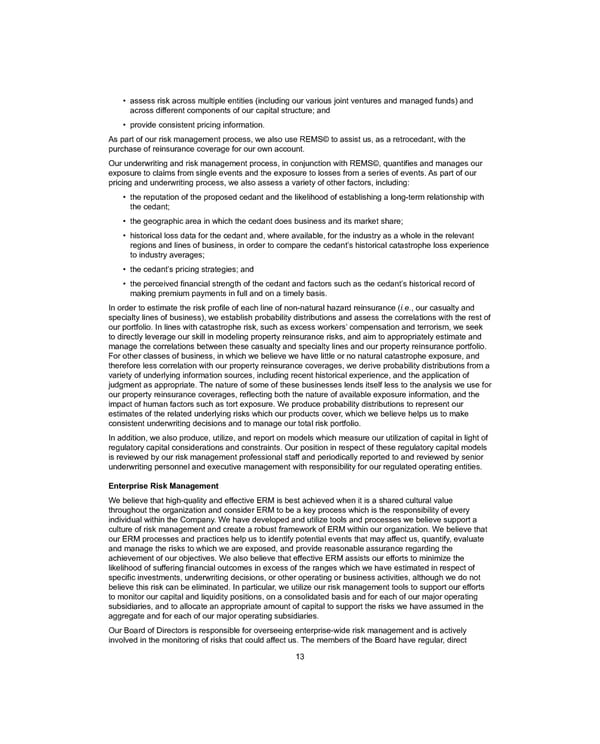• assess risk across multiple entities (including our various joint ventures and managed funds) and across different components of our capital structure; and • provide consistent pricing information. As part of our risk management process, we also use REMS© to assist us, as a retrocedant, with the purchase of reinsurance coverage for our own account. Our underwriting and risk management process, in conjunction with REMS©, quantifies and manages our exposure to claims from single events and the exposure to losses from a series of events. As part of our pricing and underwriting process, we also assess a variety of other factors, including: • the reputation of the proposed cedant and the likelihood of establishing a long-term relationship with the cedant; • the geographic area in which the cedant does business and its market share; • historical loss data for the cedant and, where available, for the industry as a whole in the relevant regions and lines of business, in order to compare the cedant’s historical catastrophe loss experience to industry averages; • the cedant’s pricing strategies; and • the perceived financial strength of the cedant and factors such as the cedant’s historical record of making premium payments in full and on a timely basis. In order to estimate the risk profile of each line of non-natural hazard reinsurance ( i.e. , our casualty and specialty lines of business), we establish probability distributions and assess the correlations with the rest of our portfolio. In lines with catastrophe risk, such as excess workers’ compensation and terrorism, we seek to directly leverage our skill in modeling property reinsurance risks, and aim to appropriately estimate and manage the correlations between these casualty and specialty lines and our property reinsurance portfolio. For other classes of business, in which we believe we have little or no natural catastrophe exposure, and therefore less correlation with our property reinsurance coverages, we derive probability distributions from a variety of underlying information sources, including recent historical experience, and the application of judgment as appropriate. The nature of some of these businesses lends itself less to the analysis we use for our property reinsurance coverages, reflecting both the nature of available exposure information, and the impact of human factors such as tort exposure. We produce probability distributions to represent our estimates of the related underlying risks which our products cover, which we believe helps us to make consistent underwriting decisions and to manage our total risk portfolio. In addition, we also produce, utilize, and report on models which measure our utilization of capital in light of regulatory capital considerations and constraints. Our position in respect of these regulatory capital models is reviewed by our risk management professional staff and periodically reported to and reviewed by senior underwriting personnel and executive management with responsibility for our regulated operating entities. Enterprise Risk Management We believe that high-quality and effective ERM is best achieved when it is a shared cultural value throughout the organization and consider ERM to be a key process which is the responsibility of every individual within the Company. We have developed and utilize tools and processes we believe support a culture of risk management and create a robust framework of ERM within our organization. We believe that our ERM processes and practices help us to identify potential events that may affect us, quantify, evaluate and manage the risks to which we are exposed, and provide reasonable assurance regarding the achievement of our objectives. We also believe that effective ERM assists our efforts to minimize the likelihood of suffering financial outcomes in excess of the ranges which we have estimated in respect of specific investments, underwriting decisions, or other operating or business activities, although we do not believe this risk can be eliminated. In particular, we utilize our risk management tools to support our efforts to monitor our capital and liquidity positions, on a consolidated basis and for each of our major operating subsidiaries, and to allocate an appropriate amount of capital to support the risks we have assumed in the aggregate and for each of our major operating subsidiaries. Our Board of Directors is responsible for overseeing enterprise-wide risk management and is actively involved in the monitoring of risks that could affect us. The members of the Board have regular, direct 13
 2021 Annual Report Page 28 Page 30
2021 Annual Report Page 28 Page 30